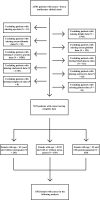Prognostic Roles of Inflammation- and Nutrition-Based Indicators for Female Patients with Cancer
- PMID: 35747251
- PMCID: PMC9211802
- DOI: 10.2147/JIR.S361300
Prognostic Roles of Inflammation- and Nutrition-Based Indicators for Female Patients with Cancer
Abstract
Purpose: The incidence, progression, and prognosis of cancer could be affected by inflammation and nutrition. Female patients have different inflammatory and nutritional states depending on their age and tumor types. It is important to screen for suitable prognostic indicators in female patients with cancer of different ages and tumor types.
Patients and methods: Baseline clinicopathologic and laboratory characteristics of 1502 female patients with cancer were obtained from a multicenter cohort study. Concordance indices (C-indices) were used to evaluate the prediction accuracy of following inflammation- and nutrition-based indicators: advanced lung cancer inflammation index (ALI), systemic immune inflammation index (SII), modified geriatric nutritional risk index (mGNRI), albumin-to-globulin ratio (AGR), prognostic nutritional index (PNI), lymphocyte-to-C-reactive protein ratio (LCR), controlling nutritional status score (CONUT), modified Glasgow prognostic score (mGPS), and lymphocyte-to-C-reactive protein score (LCS).
Results: The most suitable indicators in different female populations with cancer had C-indices as follows: LCR (0.668; 95% CI, 0.644-0.693) for all females; AGR (0.681; 95% CI, 0.619-0.743) for young females; LCR (0.667; 95% CI, 0.628-0.706) for middle-aged females; ALI (0.597; 95% CI, 0.574-0.620) for elderly females; LCR (0.684; 95% CI, 0.621-0.747) for females with reproductive system cancer; and ALI (0.652; 95% CI, 0.624-0.680) for females with non-reproductive system cancer.
Conclusion: The most suitable indicators for the different female populations with cancer are summarized as follows: LCR for all females, AGR for young females, LCR for middle-aged females, ALI for elderly females, LCR for females with reproductive system cancer, and ALI for females with non-reproductive system cancer.
Keywords: cancer; female; inflammation; nutrition; prognosis.
© 2022 Yang et al.
Conflict of interest statement
The authors report no conflicts of interest in this work.
Figures




Similar articles
-
Association between nutrition-related indicators with the risk of chronic obstructive pulmonary disease and all-cause mortality in the elderly population: evidence from NHANES.Front Nutr. 2024 Jul 16;11:1380791. doi: 10.3389/fnut.2024.1380791. eCollection 2024. Front Nutr. 2024. PMID: 39081677 Free PMC article.
-
Modified Glasgow Prognostic Score, Prognostic Nutritional Index and ECOG Performance Score Predicts Survival Better than Sarcopenia, Cachexia and Some Inflammatory Indices in Metastatic Gastric Cancer.Nutr Cancer. 2021;73(2):230-238. doi: 10.1080/01635581.2020.1749290. Epub 2020 Apr 9. Nutr Cancer. 2021. PMID: 32270713
-
A Novel Systemic Inflammation Prognostic Score to Stratify Survival in Elderly Patients With Cancer.Front Nutr. 2022 Jul 5;9:893753. doi: 10.3389/fnut.2022.893753. eCollection 2022. Front Nutr. 2022. PMID: 35866083 Free PMC article.
-
Nutritional and inflammatory measures predict survival of patients with stage IV colorectal cancer.BMC Cancer. 2020 Nov 11;20(1):1092. doi: 10.1186/s12885-020-07560-3. BMC Cancer. 2020. PMID: 33176752 Free PMC article.
-
Inflammation and nutrition-based biomarkers in the prognosis of oesophageal cancer: a systematic review and meta-analysis.BMJ Open. 2021 Sep 30;11(9):e048324. doi: 10.1136/bmjopen-2020-048324. BMJ Open. 2021. PMID: 34593492 Free PMC article.
Cited by
-
Cholesterol-modified prognostic nutritional index (CPNI) as an effective tool for assessing the nutrition status and predicting survival in patients with breast cancer.BMC Med. 2023 Dec 21;21(1):512. doi: 10.1186/s12916-023-03225-7. BMC Med. 2023. PMID: 38129842 Free PMC article.
-
Prognostic importance of modified geriatric nutritional risk index in oral cavity squamous cell carcinoma.Sci Rep. 2024 Jun 5;14(1):12921. doi: 10.1038/s41598-024-63671-y. Sci Rep. 2024. PMID: 38839809 Free PMC article.
-
Prognostic Value of Inflammation-Immunity-Nutrition Score and Inflammatory Burden Index for Hepatocellular Carcinoma Patients After Hepatectomy.J Inflamm Res. 2022 Nov 28;15:6463-6479. doi: 10.2147/JIR.S386407. eCollection 2022. J Inflamm Res. 2022. PMID: 36467989 Free PMC article.
-
Association of hemoglobin, albumin, lymphocyte, and platelet score with risk of all-cause and cause-specific mortality among cancer survivors: NHANES 1999-2018.Front Oncol. 2024 Sep 18;14:1402217. doi: 10.3389/fonc.2024.1402217. eCollection 2024. Front Oncol. 2024. PMID: 39359427 Free PMC article.
-
Association of aggregate index of systemic inflammation with increased all-cause and cardiovascular mortality in female cancer patients.Front Oncol. 2025 Apr 29;15:1552341. doi: 10.3389/fonc.2025.1552341. eCollection 2025. Front Oncol. 2025. PMID: 40365348 Free PMC article.
References
LinkOut - more resources
Full Text Sources
Research Materials

